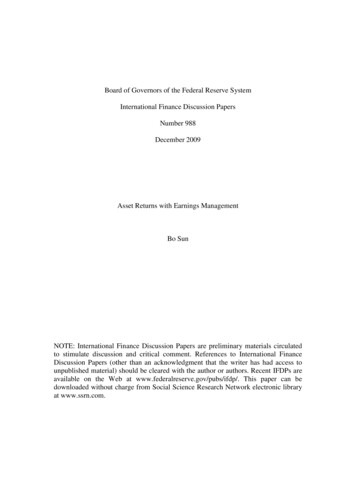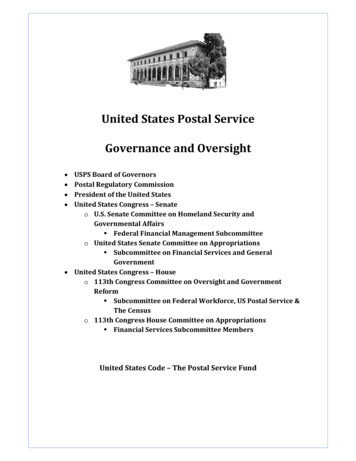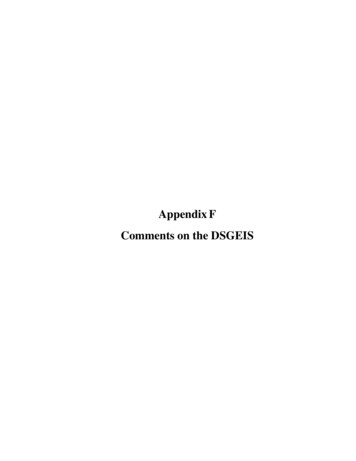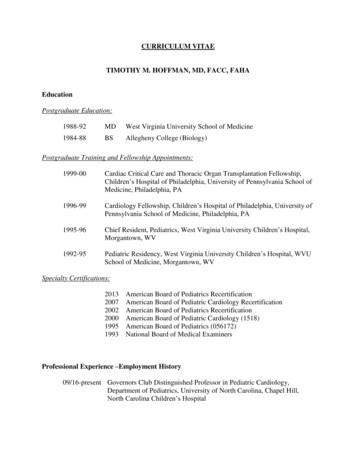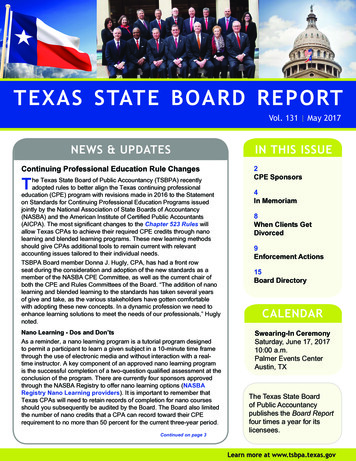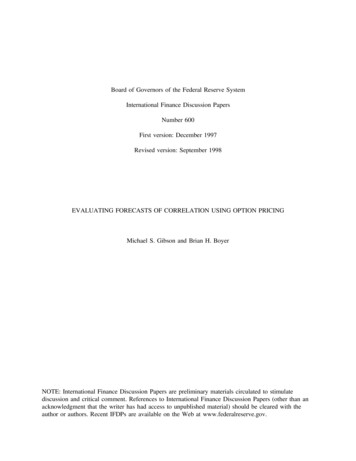
Transcription
Board of Governors of the Federal Reserve SystemInternational Finance Discussion PapersNumber 600First version: December 1997Revised version: September 1998EVALUATING FORECASTS OF CORRELATION USING OPTION PRICINGMichael S. Gibson and Brian H. BoyerNOTE: International Finance Discussion Papers are preliminary materials circulated to stimulatediscussion and critical comment. References to International Finance Discussion Papers (other than anacknowledgment that the writer has had access to unpublished material) should be cleared with theauthor or authors. Recent IFDPs are available on the Web at www.federalreserve.gov.
EVALUATING FORECASTS OF CORRELATION USING OPTION PRICINGMichael S. Gibson and Brian H. Boyer*Abstract: A forecast of the correlation between two asset prices is required to price or hedge an optionwhose payoff depends on both asset prices or to measure the risk of a portfolio whose return dependson both asset prices. However, a number of factors make it difficult to evaluate forecasts ofcorrelation. We develop a forecast evaluation methodology based on option pricing, extending atechnique that Engle et al (1993) introduced to evaluate volatility forecasts. A forecast of thevariance-covariance matrix of joint asset returns is used to generate a trading strategy for a package ofsimulated options. The most accurate forecast will produce the most profitable trading strategy. Thepackage of simulated options can be chosen to be sensitive to correlation, to volatility, or to anyarbitrary combination of the two. In an empirical application, we focus on the ability to forecast thecorrelation between two stock market indices. We compare the correlation forecasting ability of threemore sophisticated models (two GARCH models and a two-state Markov switching model) and twosimple moving averages. We find that the more sophisticated models produce better correlationforecasts than the simple moving averages.Keywords: forecast evaluation, GARCH, Markov switching, weekend effect*We thank Stephen Figlewski and participants in the First Semiannual Washington Area FinanceConference, the 8th Annual Derivatives Securities Conference, and workshops at the University ofVirginia and the Federal Reserve Board for helpful comments and suggestions. Remaining errors arethe responsibility of the authors. The first author is a staff economist in the Division of InternationalFinance. The views in this paper are solely the responsibility of the authors and should not beinterpreted as reflecting the views of the Board of Governors of the Federal Reserve System or of anyother person associated with the Federal Reserve System. The authors’ email addresses aregibsonm@frb.gov and boyerb@umich.edu.
1 IntroductionA forecast of the correlation between two financial asset prices is required to price or hedge anoption whose payoff depends on both asset prices or to measure the risk of a portfolio whose returndepends on both asset prices. However, a number of factors make it difficult to evaluate forecasts ofcorrelation. First, correlation, like volatility, is unobservable. Second, even if true correlation couldbe observed, the appropriate loss function is subject to uncertainty. Forecasts which minimize standardstatistical loss functions may not minimize economic loss functions. Third, most models that forecastcorrelation also forecast volatility. A test of such a model is a joint test, not a test of the ability toforecast correlation. To circumvent these difficulties, we propose a methodology to evaluate forecastsof correlation based on option pricing.Each correlation forecast is used to generate an option tradingstrategy. The most accurate correlation forecast will produce the most profitable trading strategy.Considerable attention has been given in the literature to forecasting volatility.1,2 The mostcommon evaluation technique is to regress squared asset returns on volatility forecasts (e.g. Lamoureuxand Lastrapes (1993) and Jorion (1995)). Another technique compares the mean square error offorecasts, with forecast error measured as the difference between squared returns and the volatilityforecast (e.g. West and Cho (1994) and Figlewski (1997)). Although both techniques use squaredreturns as the forecast benchmark and the quadratic loss function to evaluate forecast accuracy, they donot always agree on which forecast of volatility is best. Squared returns are a sensible benchmarksince they are an unbiased and consistent estimate of true volatility. However, true volatility is neverobserved. Further, there is no natural metric to measure the dollar value of volatility forecast errors.1We use the term ’volatility’ in this paper both to refer to the general variability of a time series and as a synonym forstandard deviation.2See Mayhew (1995) and Figlewski (1997) for surveys.
To overcome these difficulties, Engle et al (1993) introduced a new technique to evaluate volatilityforecasts based on the models’ ability to accurately price options.3In this paper, we extend the methodology of Engle et al (1993) to the multivariate case for thepurpose of evaluating forecasts of the entire variance-covariance matrix. One strength of ourmethodology is that it evaluates forecasts with an economically meaningful loss function: optionpricing errors. Another strength of our methodology is its ability to emphasize the accuracy of anycombination of volatility and correlation forecasts, e.g. the methodology can be tailored to identifygood forecasters of correlation, good forecasters of volatility, or good forecasters of correlation andvolatility.Little attention has been given in the literature to evaluating forecasts of correlation. A smallbut growing literature compares the forecast accuracy of implied correlation from cross-currencyoptions with correlation forecasts based on historical pairs of returns.4 However, these papers evaluateforecast accuracy using a statistical loss function, such as mean square error, not an economic lossfunction such as option pricing errors.In the next section of the paper, we set out our methodology. We describe the steps that mustbe followed each day: each forecasting model makes a forecast, each forecast is used to price andtrade options, and profits are realized based on the next day’s actual asset price movements. Wedescribe how our methodology can be tailored to focus on any desired combination of volatility andcorrelation forecasts by trading a package of options. In section 3, we explore our methodology’sperformance on simulated data. In section 4, we describe the five forecasting models we choose toimplement in our empirical application: two GARCH models, a two-state Markov switching model,3See also Noh, Engle and Kane (1994) and Engle, Kane and Noh (1997).4Campa and Chang (1997) and Walter and Lopez (1997) are two recent examples.2
and two moving averages. In section 5, we implement our methodology using data on the S&P 500and NASDAQ composite equity indices. Section 6 concludes.2 Evaluating forecasts by their ability to accurately price optionsTo evaluate forecasts of correlation, we extend the methodology of Engle et al (1993), whobased their evaluation of univariate volatility forecasting models on the models’ ability to accuratelyprice options. We specify a group of forecasting "agents," each with her own forecasting model forthe variance-covariance matrix of joint returns on two assets.5 The forecasting agents price and tradean option whose payoff depends on the two asset prices (a "rainbow option"). Each forecasting agentis assumed to be risk-neutral.For each day t in our sample, the following sequence is followed:Each agent forecasts the variance-covariance matrix of joint returns between t-1 and t, using1.past returns through day t-1.62.Each agent uses her forecasts of volatility and correlation to price a 1-day European rainbowoption whose payoff depends on the date t returns on the two assets.3.Agents trade options among themselves. For each pair of agents, the agent whose forecastleads to a higher option price buys one option from the agent whose forecast leads to a loweroption price. With n forecasting agents, each agent will make n-1 trades each day. Werestrict the trade amount to a single option.7 Each trade takes place at the mean of the two5The five forecasting models we use in our empirical tests are described in Section 4 below. In the simulations presentedin Section 3, the agents use static forecasts that do not require any estimation.6For an analysis of correlation forecasting that uses more information than just past returns, see Karolyi and Stulz (1996).7This restriction is necessary to limit the amount of trading, since two risk-neutral agents who put different values on anoption would want to trade an infinite quantity of the option. A more involved alternative would be to specify each agent’srisk preferences, have each agent compute the risk of each trade (incorporating the forecast uncertainty), and have agentsbargain over an amount and a price for each day’s trade. We have chosen the simpler alternative.3
agents’ prices. The "bank account" of the option-selling agent is credited with the amount ofthe option premium, and the "bank account" of the option-buying agent is debited the sameamount.4.Each agent hedges her exposure to both of the underlying asset prices by selling short anumber of shares of each asset equal to the agent’s estimate of the "delta" of her optionposition with respect to that asset.8 Hedging is done by buying or selling at date t-1 prices.Each agent’s "bank account" is credited with the amount of the short sales (or debited if thehedge is a long position in the underlying asset).5.The "bank account" balances earn one day’s interest at the risk-free rate. Negative balancesare charged interest at the risk-free rate.6.Using actual date t returns, the rainbow option’s payoff is calculated. The "bank account" ofeach agent who bought options is credited with the payoff amount (which is zero if the optionexpires out of the money). The hedge positions are sold at date t prices.7.Each agent’s final "bank account" balance represents her profit from the day’s trading.Forecasting agents with more accurate forecasts should, on average, earn higher profits.2.1 Choosing an option pricing modelOur methodology requires each agent to price a 1-day rainbow option. In principle, eachagent should use an option pricing model specific to the data generating process assumed by thatagent. For example, an agent who forecasts assuming a stationary lognormal distribution for returnswould use an extension of the Black-Scholes model to price rainbow options, an agent who forecastsassuming returns follow a GARCH process should use a GARCH option pricing model, and so on.While it would be possible to price a European rainbow option under any assumed datagenerating process, either by solving a partial differential equation or using Monte Carlo techniques,8The instantaneous delta is used for hedging, and the hedge is not rebalanced before the option expires.4
doing so for all of the data generating processes assumed by the various forecasting agents wouldincrease the computational burden of our methodology. For some data generating processes (i.e. thosewith stochastic volatility), no-arbitrage pricing methods could be inappropriate and an equilibriummodel, involving additional assumptions on preferences, could be required. To reduce thecomputational burden of our methodology, we follow Engle et al (1993) and require all forecastingagents to use a common option pricing model--an extension of the Black-Scholes model to rainbowoptions, assuming stationary lognormal returns. Under the Black-Scholes assumptions, analyticsolutions are available for several rainbow options and simple numerical techniques can providesolutions for other rainbow options.Although it simplifies computation, forcing all forecasting agents to price options under theBlack-Scholes assumptions will introduce some error. We believe the error will be small because allthe options we consider in this paper expire in one day and are either at the money or close to themoney. In addition, imposing a common option pricing model on all agents removes one of the twoways a forecasting agent could outperform her competitors: by a superior forecast of correlation and/orvolatility, or by a superior option pricing model. Consequently, our results will be biased againstfinding any differences among forecasting agents.2.2 The relative importance of correlation and volatilityThe price of a rainbow option depends on both correlation and volatility. Time series modelsthat produce different correlation forecasts will likely produce different volatility forecasts. This posesa problem for our methodology, if we are interested in isolating the ability to forecast correlationindependently of the ability to forecast volatility.The relative importance of volatility and correlation forecasts will depend on the use to whichthose forecasts will be put. Each user of a forecast will have his or her own loss function over the5
deviation of forecast volatilities from true volatilities and the deviation of forecast correlation from truecorrelation. Algebraically, these loss functions could be written in a general way as(1)where a superscript "f" indicates a forecast, the wi are the weights attached to the volatility andcorrelation terms, and the gi(.) are functions that are minimized at zero (e.g., absolute value orquadratic). The best forecasting model for a particular application will minimize L, given a set ofweights. The choice of weights could influence which forecasting model is identified as the "best."For example, {w1 w2 w3 1} would favor a "generalist" forecasting model that does a good job offorecasting both volatility and correlation, while {w1 w2 0, w3 1} would favor a "specialist"forecasting model that does a good job forecasting correlation.One way to tailor the relative importance of volatility and correlation in our methodologywould be to vary the choice of rainbow option to be traded by the forecasting agents. Some rainbowoptions are relatively more sensitive to volatility, some to correlation. If the application of interest ispricing a particular rainbow option, choosing that rainbow option to be traded by the forecastingagents will naturally produce the correct "weights" on volatility and correlation (and would correctlyspecify the individual loss functions gi).We develop a more general way to tailor the relative importance of volatility and correlation,because we expect that the uses of correlation forecasts may be wider than simply pricing variousrainbow options. In particular, a situation where volatility risk can be hedged but correlation riskcannot implies a low cost of making an incorrect volatility forecast but a higher cost of making anincorrect correlation forecast. (In (1), this would be the case of {w1 w2 0, w3 1}.) In whatfollows, and in our empirical work, we focus on this case, because we think it is of particular interest.6
However, we stress that our methodology could be extended to handle arbitrary weights on thecomponents of the loss function L.To tailor the relative importance of volatility and correlation, we replace the single rainbowoption with a "package" of seven options: a single 1-day rainbow option and six 1-day European calloptions (three on each asset). The call options are defined to have strike prices at 100%, 101% and102% of the asset’s current price.9 We will vary the amounts of the call options contained in thepackage to tailor the sensitivity of the package’s price to the two volatilities. Buying call options willincrease the sensitivity of the package price to volatility without affecting its sensitivity to correlation,increasing the relative importance of volatility. Conversely, selling call options will reduce thesensitivity to volatility, reducing the relative importance of volatility. Forecasting agents will priceand trade the package of options in place of the single rainbow option. The rest of the methodologyas described above remains unchanged.2.3 Tailoring the methodology to focus on correlationFor our "option package" methodology, we want to find a package of options whose price issensitive to correlation but insensitive to volatility. Let V(σ1, σ2, ρ; x) represent the price of thepackage of options, which is written so as to explicitly note its dependence on the volatility of the twoassets (σ1, σ2), their correlation (ρ), and the amounts of the six call options included in the package(the 6x1 vector x).10 We adopt the convention that the first three elements of the vector x specify theamounts of the call options on asset 1 with strike prices at 100%, 101%, 102% of the current price,and the last three elements refer to calls on asset 2. We will refer to the call option on asset 1 with9Adding more than three call options on an asset does not improve the ability to tailor the sensitivity of the optionpackage’s price to volatility, because the price-volatility profiles of the additional options will be linear combinations (to theaccuracy of a computer) of the price-volatility profiles of the first three options. See footnote 13 for a discussion of how thestrike prices were chosen.10Of course, the package price will also depend on other variables including the risk-free interest rate, the dividend rateson the two assets, the time to maturity, current asset prices, and the strike prices of the individual options. These variableswill not differ across forecasting agents.7
strike price equal to the current price as C1, the call on asset 1 with strike price at 101% of the currentprice as C2, and so on. Using this notation, the function V can be written as(2)where R(σ1, σ2, ρ) is the price of the rainbow option and Cj(σ) is the price of the jth call option.Our objective to find a package of options that is insensitive to volatility but sensitive tocorrelation can be expressed as choosing x so that(3)where a superscript identifies which agent’s forecast of that variable is being used. In words, ifforecasting agent k prices the package using her own correlation forecast (ρ(k)) and any of the nforecasts of σ1 and σ2, she will come up with a constant price Vk. This condition should hold for all nforecasting agents, which implies a system of n 3 equations. Using (3) and the definition of V in (2),we can write the system of equations in matrix form as(4)where8
No exact solution to (4) will exist. The economic logic is as follows. We want to remove thesensitivity of the option package’s price to volatility by adding the appropriate amounts of six calloptions. However, each forecasting agent perceives a different price-volatility profile for the rainbowoption, because the price-volatility profile depends on the level of correlation (in other words, 2V/ ρ σ is not zero for the rainbow options we consider). We could choose a package of calloptions whose value would be perceived by one forecasting agent to be insensitive to volatility.However, the other agents would still perceive some sensitivity to volatility, and the results would stillbe sensitive to volatility.Since no exact solution will exist, we look for the least-squares solution to (4). The leastsquares solution will choose call options whose price-volatility profile comes closest to offsetting theindividual price-volatility profiles of the n forecasting agents. In algebraic terms, the least squaressolution solves(6)For large n and sufficiently heterogeneous forecasts, the matrix A will be of full rank and the leastsquares solution to (4) will be9
In other cases, the least squares solution will not be uniquely determined (the matrix A will not be offull rank). In this situation, we choose the solution with the shortest length, calculated as y A b,where A denotes the pseudoinverse (Moore-Penrose inverse).11In the context of our particular application, the criterion of "shortest length" is a useful wayfor us to choose one of the many least squares solutions. Relative to the "shortest length" solution,other solutions will include larger long and short positions in call options on the two assets. Theseother solutions involve more buying and selling of call options to get to the same place (in terms ofsmoothing out the price-volatility profile), magnifying the small option pricing errors made by pricingthe options under Black-Scholes assumptions. These other solutions would also make ourmethodology less numerically stable.We will focus in our empirical example on the case where we care only about the accuracy ofthe correlation forecast. The preceding discussion has made it clear that we can never remove allsensitivity of the option package’s price to volatility. Some residual sensitivity to volatility willremain, although we expect it will be small relative to the sensitivity to correlation. Rather thansimply hope we have done a good job of removing the sensitivity of the option package’s price tovolatility, we can check this by examining the relationship between the agents’ correlation forecastsand their option package prices. The relationship will be monotonic if we have done a good job of11See Strang (1980, section 3.4) for a discussion of the properties of the pseudoinverse.10
removing the sensitivity to volatility.12 We can check this by comparing the Spearman rankcorrelation between the correlation forecast and the option package price on each day with 1 or -1.133 Using simulations to evaluate the methodologyWe have described a methodology for evaluating forecasts of correlation that is based on theintuitive notion that a correct forecast will produce a more accurate rainbow option price than anincorrect forecast. Although it is based on a simple idea, our methodology is too complex to admit aformal proof of consistency. In place of a proof, this section of the paper demonstrates how ourmethodology performs on simulated data with simple static forecasts. We also use simulations toexamine how the methodology performs with four different rainbow options and choose one to use inthe empirical application that follows.3.1 The setup of the simulationsThe simulations will use a data generating process for the two daily asset returns consisting ofa bivariate normal distribution with means equal to zero, standard deviations of 14.1 percent(annualized) for both asset returns, and a correlation of 0.6. Unlike our empirical application, thesimulations do not distinguish between calendar time and trading time; no weekends or holidays arepresent in the simulations.14 Each simulation will be repeated for 100 trials and will include fiveforecasting agents, each of whom will make a static (constant) forecast throughout each trial. One of12Whether it will be monotonically increasing or decreasing depends on whether the price of the particular rainbow optionused is increasing or decreasing in correlation.13We chose the strike prices of the call options in the option package by doing a grid search over possible combinationsof out-of-the-money, at-the-money, and in-the-money strike prices. The strike prices of 100%, 101%, and 102% of the spotprice did the best job of isolating the effect of correlation on the option package price, as measured by the fraction of daysfor which the rank correlation between the option package prices and the correlation forecasts was 1 (using the real datafrom Section 5, not the simulated data from Section 3).14To compensate for the absence of weekends and holidays in the simulations, daily variances are multiplied by 250 (not365) when annualized.11
the five agents will make a correct forecast, one will make a correct correlation forecast but anincorrect volatility forecast, one will make a correct volatility forecast (for both assets) but an incorrectcorrelation forecast, and two will make incorrect forecasts of both volatility and correlation. We willvary several elements throughout the simulations: the sample size, the particular rainbow option usedin the option trading methodology, and whether the incorrect forecasts are "close" or "far" from thetruth.15 In this way we will get an idea (although not a proof) of how our methodology performsalong these various dimensions.When an agent makes an incorrect forecast, it is chosen at random from a predetermined set ofincorrect forecasts. We use two sets of incorrect forecast, one "close" to the truth and one "far" fromthe truth (see Table 1). The incorrect volatility forecasts are not assumed to be independent of oneanother, since in reality a biased volatility forecasting methodology is likely to be biased in the samedirection for both volatilities. To create this sort of dependence in our simulations, we force the biasof the two incorrect volatility forecasts to have the same sign by choosing the volatility of asset 1 atrandom, then choosing the volatility of asset 2 at random from the subset of incorrect volatilityforecasts that have the same direction of bias. Correlation forecast errors are assumed to beindependent of volatility forecast errors.One task of our simulations will be to compare how our methodology performs with variousrainbow options. We will examine four rainbow options: a call spread, an outperformance option, acall worst, and a basket. Table 2 shows the payoff function for each. In addition to choosing aparticular rainbow option, we must choose a strike price. We choose all strike prices to be "at themoney." Strike prices that are not at the money make the price-volatility profile more non-monotonic,which makes it harder for our "option package" technique to remove the sensitivity to volatility.15To remove an undesired source of variation across simulations, we do not vary the sequence of pseudo-random numbersused to generate the simulated return data.12
3.2 Comparing the basic methodology and the option package methodologyTable 3 shows the results of a simulation of the basic methodology, with agents trading asingle call spread option. Table 4 shows results of a simulation of the option package methodology,with a single call spread option and six call options, designed to remove the sensitivity to volatility butpreserve the sensitivity to correlation. Comparing these two will show the effect of tailoring the lossfunction to focus on the accuracy of correlation forecasts. Each table (and each of the remainingtables in this section) has two panels, corresponding to the cases where the incorrect forecasts are"close" or "far" from the truth. Each panel has a table with five columns, corresponding to the fiveforecasting agents. Each panel’s table has three rows, each corresponding to a different sample size(250 days, 1000 days, and 5000 days). Each cell of the table has three pieces of information: thenumber of trials (out of 100) in which that forecasting agent had the highest profits, the mean acrossthe 100 trials of mean daily profit, and the mean across the 100 trials of standard deviation of dailyprofit.Table 3 shows that the basic methodology can identify good forecasts and that its ability to doso is enhanced by a longer sample and when forecasts are more heterogeneous. In Panel A, the agentwith completely correct forecasts has the highest profits per day in 40 trials with N 250, 58 trialswhen N 1000, and 78 trials when N 5000. In Panel B, with more heterogeneous forecasts, themethodology does better, with the correct forecasts winning in 59, 80, and 85 trials. Notice that thebasic methodology, with a single call spread option, rewards the ability to forecast both volatility andcorrelation accurately. In particular, agent 1 does much better than agent 2, even though both haveidentical, correct forecasts of correlation.Table 4 shows that the option package methodology, trading a call spread option plus six calloptions, does a good job of reducing the sensitivity of the trading profits to volatility, enhancing theability to identify good correlation forecasts. If the package methodology were able to remove all13
sensitivity to volatility, agents 1 and 2 should have exactly equal performance, since they haveidentical correlation forecasts. But, as we discussed above, it is impossible to remove all sensitivity tovolatility. As a result, agent 1 still outperforms agent 2, but by a small margin. In Panel B, agent 1has the highest profits in 52 trials with N 250, compared with 33 for agent 2. At N 5000, thepackage methodology correctly identifies one of the two agents with the correct correlation forecast in98 of 100 trials. This compares with 87 out of 100 in Table 3 when trading the single call spreadoption.3.3 Comparing four rainbow optionsThe simulations reported in Table 3 and Table 4 used a call spread option as the rainbowoption that was priced and traded by the forecasting agents. Different rainbow options have differentrelative sensitivities to correlation and volatility, creating some variation in how well the optionpackage methodology can remove the sensitivity to volatility. To choose a particular rainbow optionto use in our empirical application, we repeat our simulations of the option package methodology withthe three remaining rainbow options from Table 2 and compare the results.Table 5 presents results using an outperformance option. Table 6 presents results using a callworst option. Table 7 presents results using a basket option (with weights equal to one-half). Wecompare the results in these three tables with those in Table 4 for the call spread option. The statisticwe choose to compare across tables is the number of times one of the two agents with a correctcorrelation forecast had the highest profits, which will be the sum of the numbers on the first line ofthe leftmost two columns. We look at the results for a sample size of 5,000 because the dataset weuse in our empirical application
We specify a group of forecasting "agents," each with her own forecasting model for the variance-covariance matrix of joint returns on two assets.5The forecasting agents price and trade an option whose payoff depends on the two asset prices (a "rainbow option"). Each forecasting agent is assumed to be risk-neutral.


